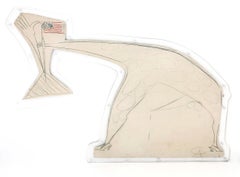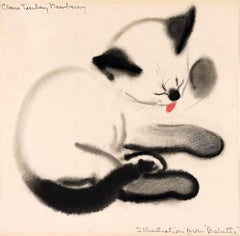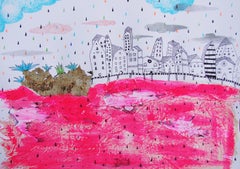Alexander Calder Animal Drawings and Watercolors
The American sculptor Alexander Calder is known as the father of the mobile, a moving artwork composed of delicately balanced sculptural forms suspended from the ceiling.
Because Calder's parents, both artists themselves, did not want him to suffer the hardships of trying to make a living in art, they encouraged the young Calder to study mechanical engineering at the Stevens Institute of Technology, in Hoboken, New Jersey. He worked a number of jobs, including as a hydraulic engineer and draftsman for the New York Edison Company, before deciding to pursue an artistic career. He never abandoned his engineering background, however, applying his understanding of gears and moving parts in all his artworks, from mechanical toys like the Cirque Calder (1931) and his revered prints to his free-standing abstract sculptures, called stabiles.
In 1926, Calder moved to Paris and established a studio in the Montparnasse quarter. He began creating the many parts of his famous miniature circus from found materials, such as wire, string, cloth, rubber and cork. Designed to be transportable, Cirque grew to fill five suitcases over the years. Always interested in putting forms in motion, Calder also pioneered a new art form called wire sculptures, which he described as “drawings in space.” Like his famous mobiles, the wire sculptures were suspended so that they turned with any movement of the air, presenting different forms when viewed from different angles.
In the 1950s, Calder returned to his roots in mechanical engineering, creating monumental abstract sculptures that verged on the architectural. He worked from loose gestural drawings like this preparatory sketch for his Man Stabile, from 1966. Throughout his career, he also worked as a set designer for the theater, as well as an illustrator and printmaker, producing vibrant, whimsical drawings for books and journals.
Find original Alexander Calder art today on 1stDibs.
1960s Surrealist Alexander Calder Animal Drawings and Watercolors
Paper, Crayon, Pencil
1930s American Impressionist Alexander Calder Animal Drawings and Watercolors
Paper, Crayon, Watercolor, Pencil
2010s Surrealist Alexander Calder Animal Drawings and Watercolors
Paper, Color Pencil
2010s Surrealist Alexander Calder Animal Drawings and Watercolors
Paper, Color Pencil, Acrylic
Mid-20th Century Surrealist Alexander Calder Animal Drawings and Watercolors
Ink, Acrylic, Watercolor, Graphite, Paper
1970s Surrealist Alexander Calder Animal Drawings and Watercolors
Paper, India Ink, Pen, Pencil
1960s Minimalist Alexander Calder Animal Drawings and Watercolors
Paper, Crayon, Graphite
2010s Contemporary Alexander Calder Animal Drawings and Watercolors
Crayon, Wood Panel, Paper, Acrylic, Watercolor, Pencil
1940s Surrealist Alexander Calder Animal Drawings and Watercolors
Paper, Pencil
21st Century and Contemporary Alexander Calder Animal Drawings and Watercolors
Oil Pastel, Archival Paper, Pencil
2010s Contemporary Alexander Calder Animal Drawings and Watercolors
Paper, Ink, Pencil, Oil Pastel
2010s Contemporary Alexander Calder Animal Drawings and Watercolors
Crayon, Paper, Acrylic, Watercolor, Wood Panel, Pencil
2010s Contemporary Alexander Calder Animal Drawings and Watercolors
Paper, Pastel, Ink, Pencil, Color Pencil
Alexander Calder animal drawings and watercolors for sale on 1stDibs.
- 1stDibs ExpertOctober 12, 2021The American sculptor Alexander Calder is known as the father of the mobile, a moving artwork composed of delicately balanced sculptural forms suspended from the ceiling. On 1stDibs, find a variety of vintage Alexander Calder drawings and other sculptures.
- Where is Alexander Calder’s art?1 Answer1stDibs ExpertApril 5, 2022Alexander Calder’s artwork has found its home in many museums and art galleries around the world, including the Museum of Modern Art and the Guggenheim Museum. Shop a selection of Alexander Calder’s pieces from some of the world’s top art dealers on 1stDibs.
- 1stDibs ExpertApril 5, 2022The American sculptor Alexander Calder invented the mobile, a moving artwork composed of delicately balanced sculptural forms suspended from the ceiling. His mobiles were an innovative feat and initially used motors for movement, which he later abandoned for air currents alone. Calder was also a pioneer of wire sculptures. Shop a selection of Alexander Calder pieces from some of the world’s top art dealers on 1stDibs.
- 1stDibs ExpertAugust 15, 2024Alexander Calder was famous for his work as an artist. The American sculptor is known as the father of the mobile, a moving artwork composed of delicately balanced sculptural forms suspended from the ceiling. He also created large-scale sculptures that frequently involved kinetic elements. Some of his best-known works include Mobile (Arc of Petals), Cirque Calder, Josephine Baker (III), Fish and A Universe. On 1stDibs, explore a selection of Alexander Calder art.
- 1stDibs ExpertOctober 15, 2024Most artists consider Alexander Calder to be a Kinetic artist rather than a Surrealist. The American sculptor is known as the father of the mobile, a moving artwork composed of delicately balanced sculptural forms usually suspended from the ceiling. Calder also pioneered a new art form with wire sculptures, which he described as “drawings in space.” Like his famous mobiles, the wire sculptures were suspended so that they turned with any air movement, presenting different forms when viewed from different angles. Explore a diverse assortment of Alexander Calder art on 1stDibs.
- 1stDibs ExpertMarch 22, 2022Alexander Calder is best known for his sculptures. He produced large, playful freestanding and hanging works in vibrant colors. Examples include Mobile-Stabile, Lobster Trap and Fish Tail and Flying Dragon. On 1stDibs, you can shop a selection of Alexander Calder art.
- 1stDibs ExpertApril 5, 2022American artist Alexander Calder is best known for his work in sculpture, particularly his monumental sculptures and innovative ‘mobiles’ in the tradition of kinetic art. Shop a collection of authentic Alexander Calder pieces from some of the world’s top art dealers on 1stDibs.
- 1stDibs ExpertMay 3, 2024Alexander Calder mostly made sculptures, although he also worked in printmaking, painting, performance and other media. He is known as the father of the mobile, a moving artwork composed of delicately balanced sculptural forms suspended from the ceiling. Some of his most famous works include Cirque Calder, A Universe, Josephine Baker (III), Mobile (Arc of Petals), Devil Fish, Romulus and Remus and Fish. On 1stDibs, find a variety of Alexander Calder art.
- 1stDibs ExpertApril 5, 2022Alexander Calder's mobiles were revolutionary because he largely pioneered the art form of creating hanging sculptures that were able to move freely in response to airflow. Calder was a prolific artist believed to have produced more than 22,000 works during his life. Shop a variety of Alexander Calder art on 1stDibs.
- 1stDibs ExpertApril 5, 2022There are several interpretations of how to describe the characteristics of Alexander Calder’s sculptures. Some say they are abstract, with life-like elements, others say they are flat, simplified shapes that intersect at opposing angles. See the magic for yourself — shop a selection of Alexander Calder pieces from some of the world’s top art dealers on 1stDibs.
- 1stDibs ExpertApril 5, 2022The term ‘mobile’, which was coined by Marcel Duchamp, was used to describe Alexander Calder’s work, as Calder’s sculptures often moved with the help of motors or wind. ‘Mobiles’ was a French pun which meant ‘motion’. On 1stDibs, find a variety of original artwork from Alexander Calder.
- 1stDibs ExpertOctober 24, 2024How much an Alexander Calder mobile is worth depends on its historical significance, size, condition and other factors. In 2012, his 1945 piece Lily of Force sold for $18.5 million at auction in New York City. The American sculptor is known as the father of the mobile, a moving artwork composed of delicately balanced sculptural forms suspended from the ceiling. Always interested in putting forms in motion, Calder also pioneered a new art form called “wire sculptures,” which he described as “drawings in space.” Like his famous mobiles, the wire sculptures were suspended so that they turned with any movement of the air, presenting different forms when viewed from different angles. If you're in possession of a Calder mobile, a certified appraiser or knowledgeable art dealer can help you determine how much it may be worth. On 1stDibs, explore a range of Alexander Calder art.
- 1stDibs ExpertApril 16, 2024Alexander Calder used many of the elements of art when producing his works. The American sculptor is known as the father of the mobile, a moving artwork composed of delicately balanced sculptural forms suspended from the ceiling. These kinetic pieces use color, shape and space to convey a sense of unity, and the form of the art allows it to interact with its environment. Find a variety of Alexander Calder art on 1stDibs.
- 1stDibs ExpertMay 3, 2024The art movement that Alexander Calder was connected to was kinetic art. The term refers to art that moves or has the appearance of movement. With their ability to sway and turn once suspended, Calder's mobiles are often referenced as examples of kinetic art. On 1stDibs, find a selection of Alexander Calder art.
- 1stDibs ExpertApril 3, 2024Alexander Calder invented the mobile, a moving artwork composed of delicately balanced sculptural forms suspended from the ceiling. The revered American sculptor's mobiles were an innovative feat and initially used motors for movement, which he later abandoned for air currents alone. Calder was also a pioneer of wire sculptures. (He was a celebrated modernist printmaker, too, and while jewelry was a secondary métier for him, interest in his wearable art has accelerated in recent years.)
For Calder, the fascinating moment of artistic alchemy comes sometime between his representational canvases of the late 1920s and 1931, the year of his first show of abstract sculpture. Moving to Paris helped spur his creativity, as it did for so many artists and writers. The moment Calder arrived, he began working on one of his most seminal pieces, Cirque Calder (1931), his delightful distillation of the circus into what are essentially three-dimensional line drawings made with wire.
Shop authentic Alexander Calder prints, sculptures and other art from some of the world’s top art dealers on 1stDibs. - 1stDibs ExpertApril 5, 2022Like all meaningful works of art, the mood that best describes American artist Alexander Calder’s sculptures is subject to interpretation. Common descriptors for his abstract work include “playful” or “whimsical.” Calder is best known as the father of the mobile, a moving artwork composed of delicately balanced sculptural forms suspended from the ceiling. Shop a selection of Alexander Calder pieces from some of the world’s top art dealers on 1stDibs.
- 1stDibs ExpertMarch 13, 2024Alexander Calder produced more than 22,000 works of art during his lifetime. The prolific artist made paintings, drawings, prints, tapestries, stage sets, jewelry and other types of art. Some of his most famous pieces include Cirque Calder, Josephine Baker (III), A Universe, Mobile (Arc of Petals) and Devil Fish. Shop a diverse assortment of Alexander Calder art on 1stDibs.


